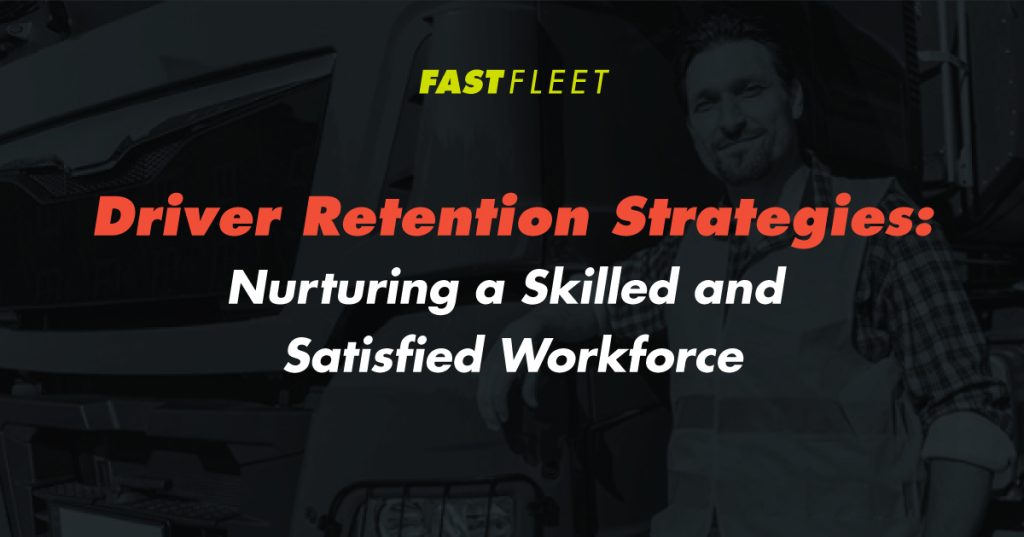Driver Retention Strategies: Nurturing a Skilled and Satisfied Workforce
In the dynamic world of trucking, retaining skilled drivers is not just a challenge but a critical necessity for sustainable operations.
The high turnover rates in the industry not only impact individual companies but also contribute to broader concerns about driver shortages.
In this blog, we delve into the challenges of driver retention, exploring effective strategies to foster a positive work environment, implement impactful training programs, and leverage technology to enhance job satisfaction.
The trucking industry faces unique challenges in retaining its workforce. Driver turnover rates have been a persistent concern, affecting operational efficiency and, ultimately, the bottom line. It’s crucial to understand the factors leading to high turnover and, more importantly, to identify and implement strategies that address these challenges.
II. Challenges in Driver Retention
Driver retention in the trucking industry has long been an uphill battle, with high turnover rates presenting a persistent challenge. Several factors contribute to this phenomenon, and unraveling these complexities is crucial for devising effective retention strategies.
a. Demanding Nature of the Job
Trucking is inherently demanding. Long hours on the road, extended periods away from home, and the physical toll of driving can take a toll on a driver’s well-being. Understanding and addressing these challenges are pivotal for creating a work environment that supports the overall health and satisfaction of drivers.
b. Lack of Work-Life Balance
The nature of the job often translates to a lack of work-life balance. Finding an equilibrium between professional responsibilities and personal life becomes a significant hurdle. Retention strategies need to incorporate measures that acknowledge and rectify this imbalance, fostering an environment where drivers feel their personal lives are valued.
c. Limited Career Development Opportunities
Perceptions of limited career growth within the industry contribute to turnover. Effective retention strategies should include pathways for professional development and clear trajectories for career advancement. Providing ongoing training, mentorship programs, and opportunities for skill diversification can significantly impact how drivers perceive their long-term prospects.
d. Communication Gaps
Effective communication is the cornerstone of a positive work environment. Often, drivers might feel disconnected or undervalued due to inadequate communication channels. Addressing this requires fostering open lines of communication, where drivers feel heard, acknowledged, and informed.
e. Competitive Job Market
In a competitive job market, drivers have more choices. Offering competitive pay is just one aspect; companies also need to differentiate themselves by providing unique benefits, acknowledging the individual needs of drivers, and creating a workplace culture that stands out.
f. Impact of Industry Changes
Changes in regulations, technological advancements, and shifts in industry dynamics can impact driver satisfaction. Keeping drivers informed about these changes and involving them in the adaptation process can mitigate uncertainties and build a sense of belonging.
Understanding these challenges lays the groundwork for tailoring retention strategies that directly address the industry’s unique pain points. The commitment to change begins with acknowledging and actively working to overcome these challenges, creating a more resilient and satisfied driving workforce.
III. Understanding the Root Causes
a. Long Hours Away from Home
Challenge:
One of the primary stressors for truck drivers is extended periods away from home. The isolation and separation from family and familiar surroundings can lead to burnout and dissatisfaction.
Solution:
Implement strategies that promote a healthier work-life balance. This could involve optimizing routes to minimize time away, providing flexible scheduling options, or even exploring technologies that enable virtual connections with families during downtime.
b. Challenging Working Conditions
Challenge:
The demanding nature of the job, including long hours of driving, navigating diverse weather conditions, and dealing with traffic, contributes to the perceived difficulty of the profession.
Solution:
Investing in driver comfort and safety can significantly impact job satisfaction. This includes maintaining well-equipped rest areas, providing state-of-the-art vehicles with driver-friendly features, and offering resources to cope with the challenges of the road.
c. Lack of Recognition
Challenge:
Feeling undervalued and under-recognized is a common driver grievance. Without acknowledgment of their crucial role in the supply chain, drivers may seek opportunities where their contributions are appreciated.
Solution:
Recognition programs, whether through awards, bonuses, or public acknowledgment, can go a long way. Establishing a culture of appreciation, where drivers are regularly recognized for their efforts, fosters a sense of pride and loyalty.
d. Limited Career Advancement Opportunities
Challenge:
Perceptions of a static career with limited growth potential can drive skilled drivers away. When the job feels like a dead-end, retaining top talent becomes an uphill battle.
Solution:
Developing clear career paths, offering ongoing training programs, and providing opportunities for skill diversification demonstrate a commitment to the professional growth of drivers. This not only enhances their skills but also communicates that the company is invested in their long-term success.
e. Inadequate Communication
Challenge:
Communication gaps contribute to feelings of isolation and dissatisfaction. Drivers who are uninformed or feel disconnected from the company may seek opportunities where they have a more transparent and open line of communication.
Solution:
Establishing regular, transparent communication channels is essential. This includes not only relaying crucial information but also actively seeking feedback from drivers. Town hall meetings, regular newsletters, or digital communication platforms can bridge these gaps.
f. Impact of Industry Changes
Challenge:
The trucking industry is dynamic, with constant regulatory changes, technological advancements, and shifts in market dynamics. Drivers who feel unprepared or uninformed about these changes may seek stability elsewhere.
Solution:
Proactive engagement and education are key. Companies should keep drivers informed about industry changes, involve them in adaptation processes, and provide the necessary training to navigate new technologies and regulations.
Addressing these root causes demands a strategic and integrated approach. By acknowledging and actively mitigating these challenges, companies can foster an environment where drivers feel supported, valued, and inclined to stay for the long haul.
IV. Building a Positive Work Environment
Creating a positive work environment is fundamental to retaining skilled drivers. Happy drivers are more likely to stay, reducing turnover rates and fostering a culture of loyalty.
a. Balancing Work-Life
Addressing the issue of long hours away from home involves a delicate balance. Implementing realistic schedules that prioritize drivers’ time with their families contributes to job satisfaction.
b. Enhancing Working Conditions
Investing in the comfort and safety of the working environment, such as quality rest areas and well-maintained vehicles, significantly impacts driver satisfaction.
V. Recognition and Incentives
Recognizing the hard work and dedication of drivers is not just a nicety; it’s a strategic necessity for any fleet aiming to retain its workforce. A thoughtful approach to recognition, coupled with performance-based incentives, can significantly enhance job satisfaction and the overall work experience for drivers.
a. Importance of Recognition
Recognition as a Motivator:
Studies consistently highlight the impact of recognition on employee motivation and engagement. For truck drivers, whose work is often solitary and demanding, acknowledgment becomes a powerful motivator. It communicates that their efforts are seen, valued, and integral to the success of the company.
Boosting Morale:
Recognition doesn’t just boost individual morale; it contributes to a positive and supportive work culture. When drivers witness their colleagues being acknowledged for their hard work, it fosters a sense of camaraderie and collective pride.
b. Forms of Recognition
Public Acknowledgment:
Publicly acknowledging drivers for their achievements, whether through internal newsletters, company-wide announcements, or social media, amplifies the impact. It not only celebrates individual successes but also elevates the prestige associated with the profession.
Awards and Appreciation Events:
Organizing awards ceremonies or appreciation events adds a tangible and ceremonial dimension to recognition. Trophies, certificates, or even simple tokens of appreciation can become powerful symbols of a driver’s contribution.
c. Performance-Based Incentives
Financial Rewards:
While intrinsic recognition is crucial, tangible incentives can further enhance the appeal. Performance-based bonuses, profit-sharing programs, or even competitive salary structures for high-performing drivers demonstrate a commitment to rewarding excellence.
Non-Monetary Incentives:
Incentives need not always be financial. Non-monetary perks like flexible scheduling, preferred routes, or additional time off can be equally attractive. Tailoring incentives to align with the preferences and needs of individual drivers adds a personalized touch.
d. Driver of the Month/Year Programs
Structured Recognition:
Establishing structured programs like “Driver of the Month” or “Driver of the Year” adds a competitive yet positive element. It provides drivers with clear goals to strive for and creates a sense of healthy competition within the team.
Prizes and Recognition:
Winners of such programs can receive special privileges, exclusive parking spaces, or even additional time off. The combination of competition and recognition makes these programs impactful in driving continuous improvement.
e. Longevity Recognition
Celebrating Milestones:
Recognizing drivers based on their tenure with the company is a testament to loyalty. Milestone celebrations for years of service, accompanied by personalized messages or tokens, reinforce the idea that the company values the long-term commitment of its drivers.
Retirement Plans and Benefits:
Longevity recognition can extend into retirement plans and benefits. Offering enhanced retirement packages or exclusive benefits for drivers who spend a significant part of their careers with the company adds a layer of security and appreciation.
In conclusion, recognition and incentives form the cornerstone of a driver retention strategy. By acknowledging the unique challenges of the trucking profession and tailoring recognition programs to address these challenges, companies can not only retain their existing workforce but also attract new talent looking for an environment that values and rewards their contributions.
VI. Technology as a Retention Tool
In the modern era, technology plays a pivotal role in addressing driver retention challenges. Leveraging tech solutions can enhance job satisfaction and create a more efficient work environment.
a. Advanced Training Programs
Implementing comprehensive training programs not only equips drivers with essential skills but also demonstrates a commitment to their professional development.
b. Telematics for Enhanced Communication
Utilizing telematics systems fosters real-time communication, allowing for better connectivity between drivers and fleet management. This transparency enhances trust and contributes to a positive work atmosphere.
In the next sections, we’ll delve into more strategies, including Fast Fleet’s commitment to driver retention.
Fostering a skilled and satisfied workforce involves a multi-faceted approach.
Recognizing the unique challenges faced by truck drivers, addressing root causes, and implementing effective strategies, including acknowledgment and incentives, are crucial components.
Fast Fleet understands the intricate dynamics of the trucking industry and is committed to being a partner in your success.
Our comprehensive roadside and maintenance mechanical services, paired with a dedication to driver satisfaction, make us a reliable ally for your fleet.
In your journey toward effective driver retention, consider the support of Fast Fleet. Our certified, knowledgeable technicians are equipped to handle everything from diesel engines to electrical repairs. We offer not just mechanical solutions but a commitment to getting your trucks back on the road efficiently.
















